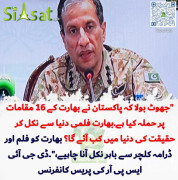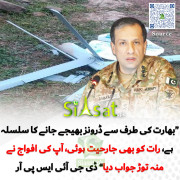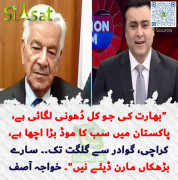Night_Hawk
Siasat.pk - Blogger
Secret files shed light on ugliness of Iraq war
NYT: Documents released by whistle-blowing website WikiLeaks detail deaths of Iraqi civilains, abuse of prisoners by American forces

The New York Times
updated 7 minutes ago 2010-10-22T21:22:17
A huge trove of secret field reports from the battlegrounds of Iraq sheds new light on the war, including such fraught subjects as civilian deaths, detainee abuse and the involvement of Iran.
The secret archive is the second such cache obtained by the independent organization WikiLeaks and made available to several news organizations. Like the first release, some 92,000 reports covering six years of the war in Afghanistan, the Iraq documents provide no earthshaking revelations, but they offer insight, texture and context from the people actually fighting the war.
A close analysis of the 391,832 documents helps illuminate several important aspects of this war:
The Iraqi documents were made available to The Times, the British newspaper The Guardian, the French newspaper Le Monde and the German magazine Der Spiegel on the condition that they be embargoed until now. WikiLeaks has never stated where it obtained the information, although an American Army intelligence analyst, Pfc. Bradley Manning, has been arrested and accused of being a source of classified material.
As it did with the Afghan war logs, The Times has redacted or withheld any documents that would put lives in danger or jeopardize continuing military operations. Names of Iraqi informants, for example, have not been disclosed. WikiLeaks said that it has also employed teams of editors to scrub the material for posting on its Web site.
WikiLeaks has been under strong pressure from the United States and the governments of other countries but is also fraying internally, in part because of a decision to post many of the Afghan documents without removing the names of informants, putting their lives in danger. A profile of WikiLeaks’s contentious founder, Julian Assange, will appear in Sunday’s newspaper.
The New York Times told the Pentagon which specific documents it planned to post and showed how they had been redacted. The Pentagon said it would have preferred that The Times not publish any classified materials but did not propose any cuts. Geoff Morrell, the Defense Department press secretary, strongly condemned both WikiLeaks and the release of the Iraq documents.
“We deplore WikiLeaks for inducing individuals to break the law, leak classified documents and then cavalierly share that secret information with the world, including our enemies,” he said.
“We know terrorist organizations have been mining the leaked Afghan documents for information to use against us and this Iraq leak is more than four times as large. By disclosing such sensitive information, WikiLeaks continues to put at risk the lives of our troops, their coalition partners and those Iraqis and Afghans working with us.”
Read the full Pentagon response.
This story, " The Iraq Archive: The Strands of a War," first appeared in The New York Times.
Copyright 2010 The New York Times
NYT: Documents released by whistle-blowing website WikiLeaks detail deaths of Iraqi civilains, abuse of prisoners by American forces

The New York Times
updated 7 minutes ago 2010-10-22T21:22:17
A huge trove of secret field reports from the battlegrounds of Iraq sheds new light on the war, including such fraught subjects as civilian deaths, detainee abuse and the involvement of Iran.
The secret archive is the second such cache obtained by the independent organization WikiLeaks and made available to several news organizations. Like the first release, some 92,000 reports covering six years of the war in Afghanistan, the Iraq documents provide no earthshaking revelations, but they offer insight, texture and context from the people actually fighting the war.
A close analysis of the 391,832 documents helps illuminate several important aspects of this war:
The Iraqi documents were made available to The Times, the British newspaper The Guardian, the French newspaper Le Monde and the German magazine Der Spiegel on the condition that they be embargoed until now. WikiLeaks has never stated where it obtained the information, although an American Army intelligence analyst, Pfc. Bradley Manning, has been arrested and accused of being a source of classified material.
As it did with the Afghan war logs, The Times has redacted or withheld any documents that would put lives in danger or jeopardize continuing military operations. Names of Iraqi informants, for example, have not been disclosed. WikiLeaks said that it has also employed teams of editors to scrub the material for posting on its Web site.
WikiLeaks has been under strong pressure from the United States and the governments of other countries but is also fraying internally, in part because of a decision to post many of the Afghan documents without removing the names of informants, putting their lives in danger. A profile of WikiLeaks’s contentious founder, Julian Assange, will appear in Sunday’s newspaper.
The New York Times told the Pentagon which specific documents it planned to post and showed how they had been redacted. The Pentagon said it would have preferred that The Times not publish any classified materials but did not propose any cuts. Geoff Morrell, the Defense Department press secretary, strongly condemned both WikiLeaks and the release of the Iraq documents.
“We deplore WikiLeaks for inducing individuals to break the law, leak classified documents and then cavalierly share that secret information with the world, including our enemies,” he said.
“We know terrorist organizations have been mining the leaked Afghan documents for information to use against us and this Iraq leak is more than four times as large. By disclosing such sensitive information, WikiLeaks continues to put at risk the lives of our troops, their coalition partners and those Iraqis and Afghans working with us.”
Read the full Pentagon response.
This story, " The Iraq Archive: The Strands of a War," first appeared in The New York Times.
Copyright 2010 The New York Times
































